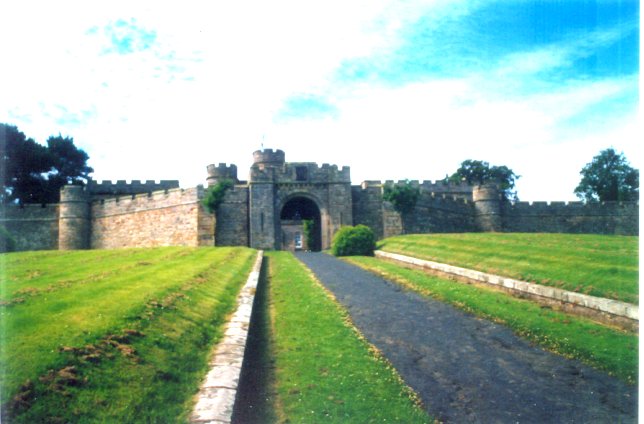Jedburgh
For Jedburgh and
district use O.S. maps
No. 74 & 80
Jedburgh has had a troubled history. Being so near the English border it was often the first place to suffer iinvasion and bloodshed. It not only suffered from attacks were by the forces of the "the Auld Enemy," England,'s mother because it would be but also by the incessant raids of the English reivers.
Jedburgh Castle was completely
demolished in 1409 by the Scottish Parliament to prevented falling in
the English hands.
On the site was built the impressive County prison in 1823.
It is no longer in use and a visit can be very rewarding. A stands
imposingly at the head of Castlegate. It appears to a been built
to keep people out rather than to keep them in.
Jedburgh developed under the protection of the authority of the great
Abbey.
Other abbey towns in the Borders are Melrose, Coldstream and Hexham.
Being only 10 miles from the Border Jedburgh was repeatedly destroyed by
the English. The castle was frequently attacked and occupied by the
English until eventually it was destroyed by the Scots themselves to
prevent the English occupying it.
Jedburgh is often regarded as an Edinburgh in miniature having a long
main street dominated by a castle, not the castle but the castle prison
which looks as if it was built to keep people out rather than to
keep people in.
Note Canongate Bridge which is 16th century.
There is so much of interest in and around Jedburgh that it calls for a prolonged stay. If you are approaching Jedburgh from the north by road stop at the woollen mills on the right. There is a large car park, cafes, and toilets and two shops stocked with woollen goods.
The menfolk of Jedburgh were noted for their bravery and was feared for their skilled use of the Jedhart axe, a four feet long steel capped pole. Time and again Jedburgh was burned and pillage by the English forces.
It was said that the good people of Jedburgh were prone to punish first and to consider the facts afterwards. This is no foundation of fact in this statement. Their sense of justice was no worse or better than that of other Borderers

Jedburgh Abbey
St Andrews Church.
The Capon Tree
he Spread Eagle Hotel
In the High Street is reputed to be the oldest hotel in Scotland.
Mary, Queen of Scots lodged here before moving to what is now The Queen’s House.
Sir Walter Scott and Robert Burns also visited the hotel.
In Castlegate you can see the house where the Young Pretender, Bonnie Prince Charlie, stayed in 1745.
This area has escaped the attention of the developers and has been restored with obvious care and sympathy.
The houses here were once thatched, as indeed were most of the houses in Jedburgh at one time.
www.jedburgh.org.uk Jedburgh Online is the official website of the Royal Burgh of Jedburgh - the town Where History & Courtesy Combine.
Southdean Church
Associated with the Battle of Otterburn.
Jedburgh
Castle
Jedburgh once had a
castle but there is no trace of it now.
It fell into English hands so often that it became a liability and
it was destroyed by the Scots themselves on the orders of Robert the Bruce
in the 15th century.
During the wars of the 16th century, Jedburgh supported the King’s
party, while nearby Ker of Ferniehirst supported the Catholic Queen.
This state of affairs and the close proximity of Jedburgh to the English
Border, contributed much to its people’s suffering.
Ferniehirst Castle
Mary, Queen of Scots' House
The
Spy at Southdean
Fatlips Castle
Around and about